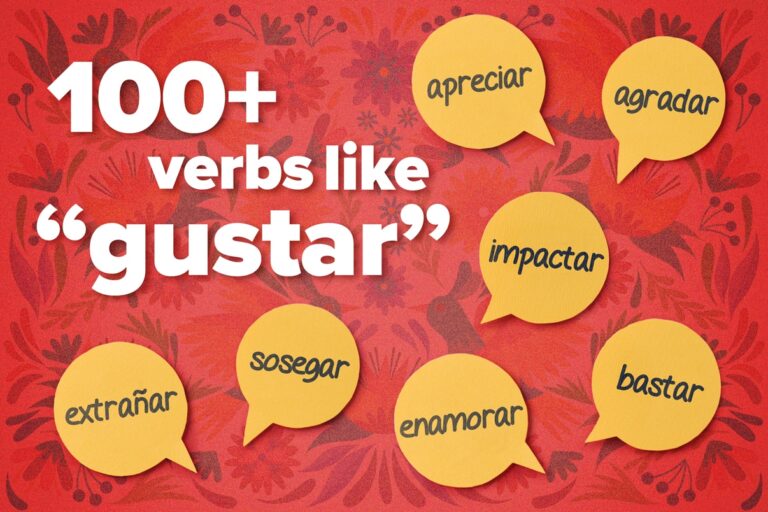Contents
- 1. Nouns are masculine or feminine in Spanish
- 2. Nouns come before adjectives
- 3. Spanish negates words with “no”
- 4. Spanish uses de to make nouns possessive
- 5. Spanish sentences can omit the subject
- 6. Spanish uses tener (to have) to express feelings
- 7. Spanish has fewer prepositions than English
- 8. Spanish doesn’t use “it” very often
- 9. Spanish capitalization and punctuation follow different rules
- 10. Spanish spelling is more straightforward
- And One More Thing…
10 Key Differences Between English and Spanish You Should Know

While Spanish may not be the most difficult language for an English speaker to learn, there are quite a few things that you might find strange and hard to grasp at first.
Here, we’ll peek at some of those tricky and seemingly-absurd concepts with the top 10 biggest differences between English and Spanish.
Download: This blog post is available as a convenient and portable PDF that you can take anywhere. Click here to get a copy. (Download)
1. Nouns are masculine or feminine in Spanish
What do an apple, your mom and scissors have in common?
They’re all feminine nouns in Spanish.
While assigning gender to objects is common in other languages, it’s almost unheard of in modern English. For native English speakers, it can be a bit overwhelming at first.
In Spanish, every noun is either masculine or feminine. You’ll know which gender it is by the article words el and la , which mean “the.”
El is masculine and la is feminine.
The word’s gender also affects adjectives and relative pronouns in the sentence. For example, if the noun is feminine, the adjective has to be feminine.
Take these two sentences as examples. The first one is masculine and the second is feminine:
El vestido es rojo.
(The dress is red.)
La camisa es roja.
(The shirt is red.)
Usually, words that end with the letter o are masculine, and words that end with the letter a are feminine. But there are many exceptions.
The easiest way to know a Spanish word’s gender is to simply memorize the article with the noun. For example, instead of learning “vestido” (dress) by itself, learn “el vestido” (the dress).
There are a few more important things to learn about the masculine and feminine in Spanish, so I recommend bookmarking this guide so you can check it out once you finish this one:
Masculine and Feminine in Spanish: What You Need to Know About Spanish Gender | FluentU Spanish Blog
Read this guide to learn about masculine and feminine Spanish gender rules. Learn how to use and determine gender, the best tips for studying gender rules, resources to…
2. Nouns come before adjectives
In Spanish, adjectives usually come after the noun. For example, if you wanted to say “the black suit” in Spanish, you’d say el traje negro (literally: the suit black).
The most challenging part of mastering adjectives could be remembering to modify them correctly. For example, if the subject is plural and feminine, the article and adjective accompanying it must also be plural and feminine.
For example:
Las flores rojas
(The red flowers)
See how the article, noun and adjective all end in –s since it’s plural? And las and rojas end in –as, since flor is feminine.
Compare that to the singular version of the sentence:
La flor roja
(The red flower)
And if it were a masculine word like el gato (the cat), the plural would be:
Los gatos rojos
(The red cats)
Once you get the hang of it, this isn’t so bad. Here are all the details you need to know about Spanish plurals:
Forming the Spanish Plural (Rules & Examples) | FluentU Spanish Blog
The Spanish plural isn’t as tricky as it looks. In fact, some Spanish pluralization rules are pretty similar to English ones! There are only eight rules you need to…
3. Spanish negates words with “no”
English commonly uses prefixes—like “non-,” “un-,” “dis-,” “in-”—to make sentences or words negative. But in Spanish sentences, just putting no before the verb will negate it, and there are fewer prefixes to confuse you.
Let’s compare a few negative sentences in English and Spanish:
I disagree with you. → No estoy de acuerdo contigo.
My boss was unsatisfied with my work. → Mi jefe no estaba satisfecho con mi trabajo.
I don’t like cheese. → No me gusta el queso.
I don’t know anything about the trip. → No sé nada del viaje.
Notice how in the last sentence, the Spanish version uses the word nada (nothing) to mean “anything.” This is correct in Spanish, even though you wouldn’t say “I don’t know nothing” in English.
Here’s a more in-depth guide to Spanish negation if you want to learn more:
Spanish Negation (Including Key Negative Words and the Double Negative) | FluentU Spanish Blog
Spanish negation is an important topic to understand, as you’ll undoubtedly find yourself needing to say no. Click here for the complete guide to negation, including the…
4. Spanish uses de to make nouns possessive
In English, all you have to do is slap an apostrophe “s” to the end of a noun, and presto: you’ve made it possessive. For example: “Adam’s jacket.”
This isn’t the case in Spanish. To specify belonging in Spanish, you have to use de to connect the possession to its owner.
So to say “Adam’s jacket” in Spanish, we would say:
La chaqueta de Adam
(Adam’s jacket)
This literally means “the jacket of Adam.”
Not too difficult, right?
Luckily, learning the rest of the possessive words isn’t difficult either. Possessive adjectives and pronouns are also used in Spanish and follow a very similar format to English.
They include words like:
Mi (my)
Tu (your)
Su (his/hers, your)
And more.
To learn them, check out our guides on possessive adjectives and possessive pronouns:
How to Use Spanish Possessive Adjectives (with Examples)) | FluentU Spanish Blog
Spanish possessive adjectives tell us who an object belongs to. Click here to learn all the possessive adjectives in Spanish, like “mi,” “tu,” “su,” etc. Learn everything…
Spanish Possessive Pronouns: What They Are and How to Use Them | FluentU Spanish Blog
Master Spanish possessive pronouns with this simple guide to usage rules, example sentences and more. Learn where to find helpful resources, like exercises and quizzes, to…
5. Spanish sentences can omit the subject
So you spent weeks memorizing the conjugations of Spanish verbs, wondering, “Why does this have to be so darn complicated?!”
They can seem stressful and overwhelming at first, but once you start forming sentences, you’ll see how simple the rest of it becomes.
Using the proper conjugation in Spanish, you already know the tense and the subject without explicitly stating it. Because of this, Spanish speakers often leave out some parts of a sentence that we would typically state in English, such as the subject.
For example, when conjugating the verb comer into the first person (como), you already know that the subject is “I.”
Here are a few examples of English sentences that include the subject compared to Spanish ones that exclude it:
I sleep in my sister’s room. → (Yo) Duermo en la habitación de mi hermana.
You go to the gym on Mondays. → (Tú) Vas al gimnasio los lunes.
He buys flowers for his mom. → (Él) le compra flores a su mamá.
If Spanish conjugation is still something you’re trying to wrap your head around completely, I recommend reading this guide:
Understanding Spanish Verb Conjugation | FluentU Spanish Blog
Spanish verb conjugation is a key step in learning the language. This guide will walk you through the basics of conjugating in Spanish as well as examples and tips. Not…
6. Spanish uses tener (to have) to express feelings
In Spanish, there are several instances where the verb tener (to have) is used to say phrases expressed with “to be” in English.
Tener is often used when speaking about something that is attributed to us or something that we are experiencing.
A few things that are expressed with tener include:
1. Age
Tengo 18 años.
(I’m 18 years old.)
Mi hermana tiene menos años que yo.
(My sister is younger than me.)
2. States of being
Ya son las dos de la tarde y no hemos almorzado, tienes hambre?
(It’s already two o’clock in the afternoon and we haven’t had lunch, are you hungry?)
El sol es tan fuerte hoy, tengo sed.
(The sun is so strong today, I’m thirsty.)
¡Tengo prisa! Voy a tardar.
(I’m in a hurry! I’m going to be late.)
Tengo miedo de las serpientes.
(I’m scared of snakes.)
The list doesn’t end there, but now that you’re aware of this phenomenon, you can watch out for it as you progress with your Spanish. For more phrases and expressions that use the verb tener, check out this guide next:
https://www.fluentu.com/blog/spanish/spanish-expressions-with-tener/
7. Spanish has fewer prepositions than English
In, over, under, about, on, across, behind… In English, we use dozens of prepositions to determine an object’s location. But in Spanish, there are significantly fewer. For example, in many cases, we would use “in,” “on,” and “at” in English. But we just use the word en in Spanish.
Here are a few examples to help you out:
La manzana está en el refrigerador.
(The apple is in the refrigerator.)
Mi perro se sienta en la alfombra.
(My dog sits on the carpet.)
Estoy en la fiesta.
(I am at the party.)
The word de in Spanish can also replace many English prepositions. It can mean “from,” “in,” “of” and in some cases even more. Here are a few more examples:
Soy de Tejas.
(I am from Texas.)
Los Estados Unidos de América (The United States of America)
Distinguishing which preposition to use and when may confuse some Spanish learners, but with the smaller pool of words to choose from, it shouldn’t take too long to master.
Here’s a full guide to Spanish prepositions if you want to learn more:
Spanish Prepositions and How to Use Them | FluentU Spanish Blog
Spanish prepositions are an essential part of the language! Read up on the 40 most common prepositions in Spanish, together with their usage and example sentences. This…
8. Spanish doesn’t use “it” very often
It seems like it would be hard to speak without using the word “it,” right? I mean, I just used it three times in the previous sentence.
We use the word in these contexts daily in English, while it’s found much less often in Spanish. This is primarily because #5 exists—subjects are inferred through the conjugated verb.
For example, two of the instances of “it” in the first sentence could be replaced with these verbs:
Parece…
(It seems…)
Sería…
(It would be…)
Here’s another example: We’d say “it is big” in English, but in Spanish, you only have es grande. The same suit is followed for many similar sentences.
For example:
“Has probado ceviche?”
(Have you tried ceviche?)
“¡Sí, es muy rico!”
(Yes, it’s very good!)
“Te gustan estos zapatos?”
(Do you like these shoes?)
“Sí, pero son demasiados grandes.”
(Yes, but they’re too big.)
9. Spanish capitalization and punctuation follow different rules
Sentence punctuation in Spanish
While much of the punctuation in English and Spanish writing stays the same, there are a few slight differences to note. In English, punctuation only comes at the end of a sentence. Whereas in Spanish, when asking a question or expressing excitement, punctuation is placed at both the beginning and the end.
An upside-down question mark or exclamation point will start the sentence, and a right-side-up mark will end it.
For example:
¡Qué suerte!
(How lucky!)
¿Quieres cenar conmigo mañana?
(Do you want to have dinner with me tomorrow?)
Words that aren’t capitalized in Spanish
There are just a few simple differences in capitalization. Some words that are capitalized in English are not in Spanish. These include:
- Days of the week ( el lunes — Monday, el martes —Tuesday, el miércoles — Wednesday)
- Months of the year ( enero — January, febrero — February, marzo — March)
- Nationalities ( mexicano — Mexican, estadounidense — American/from the U.S., chino — Chinese)
- Languages ( español — Spanish, inglés — English, francés — French)
- Religions and religious adjectives ( cristianismo — Christianity, cristiano — Christian, musulmán — Muslim)
Number punctuation in Spanish
Spanish numbers use a period to separate them by the thousands instead of a comma. A comma will separate whole numbers from decimals. For example, thirteen-thousand dollars and twelve cents would be written as $13.000,12 in Spanish.
Here are a few more related guides that I can recommend:
https://www.fluentu.com/blog/spanish/spanish-captialization/
Most Important Spanish Punctuation Marks | FluentU Spanish Blog
Read our Spanish punctuation lesson to learn about how to use periods, commas, semicolons, exclamation marks, question marks and two unique options for quotation marks.…
https://www.fluentu.com/blog/spanish/upside-down-question-mark/
10. Spanish spelling is more straightforward
Why don’t “cough” and “dough” rhyme? And what’s with “gnat” and “knot”?
We can have spelling bees in English because of how irregular, difficult and unintuitive spelling can be. In Spanish, usually spelling a word is so simple that you can figure it out just by sounding it out.
While in English, letters can sound long, short or even silent—creating over a dozen different vowel sounds—in Spanish, there are only five. Better yet, each vowel only has one sound.
This will be a relief down the road. But for starters, learning how to use the letters may be difficult for non-native speakers.
While we use the same letters, how some are pronounced can sound different in Spanish. And additions like diaeresis, accents and tildes must also be used.
The most trouble comes from the false cognitive sound of letters.
For example, the Spanish letter “v” is often pronounced like an English “b.” And what sounds like an English “y” is actually a Spanish “ll.”
Here’s a full guide breaking down Spanish spelling if you’re still trying to grasp it:
https://www.fluentu.com/blog/spanish/spanish-spelling/
Another resource that can help is FluentU, a language learning program where you learn with authentic videos from real Spanish sources.
FluentU takes authentic videos—like music videos, movie trailers, news and inspiring talks—and turns them into personalized language learning lessons.
You can try FluentU for free for 2 weeks. Check out the website or download the iOS app or Android app.
P.S. Click here to take advantage of our current sale! (Expires at the end of this month.)

No one ever said learning Spanish is a breeze. But by knowing 10 main ways that it differs from English, learning will be that much easier.
Download: This blog post is available as a convenient and portable PDF that you can take anywhere. Click here to get a copy. (Download)
And One More Thing…
If you want to learn Spanish with authentic materials but need a little extra support, then you need to know about FluentU.
FluentU lets you consume the same content as native Spanish speakers, but with tools to make it easier to pick up the language while you watch. You’ll learn Spanish as it’s actually spoken by real people, unlike programs that use scripted content.
You can bring our learning tools directly to YouTube or Netflix with the FluentU Chrome Extension, or check out our curated video library full of clips that cover a wide range of topics, as you can see here:
FluentU brings native videos within reach with interactive subtitles. You can tap on any word to instantly see its meaning, an image, and its audio pronunciation. Click on the word for additional examples and to add it to your flaschards.
To reinforce what you've learned, you'll complete engaging exercises and see more examples of the key words from the video. FluentU keeps track of the vocab you’re learning, and gives you extra practice with difficult words.
Start using the FluentU website on your computer or tablet or, better yet, download the FluentU app from the iTunes or Google Play store. Click here to take advantage of our current sale! (Expires at the end of this month.)











